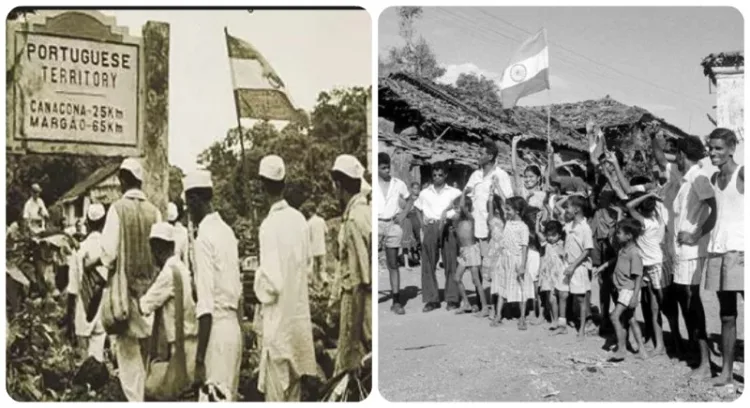The liberation of Goa, a Portuguese colony for over 450 years, stands as a testament to India’s relentless pursuit of sovereignty and justice. Spearheaded by a coalition of political parties, activists, and ordinary citizens, the movement highlighted the grit and determination of the Indian people in the face of oppressive colonial rule.
Launch of the Goa Satyagraha
The Goa Liberation Movement gained momentum on June 13, 1955, with the launch of the Goa Satyagraha. Jagannath Rao Joshi, a leader of the Bharatiya Jana Sangh, along with volunteers from the Rashtriya Swayamsevak Sangh (RSS) in Karnataka, initiated the satyagraha, mobilising a massive force of 3,000 workers, including women. As they reached Goa’s borders, they were met with brutal resistance from Portuguese forces, who resorted to lathi charges and firing.
The situation escalated on August 15, 1955, when over 5,000 satyagrahis entered Goa carrying the slogan “Portuguese Quit India.” Despite being unarmed, they faced incessant gunfire from Portuguese soldiers. That day, 51 protesters were martyred, and more than 300 were injured. This act of defiance, occurring on the 9th anniversary of India’s independence, underscored the deep resolve of Indians to liberate Goa.
Contributions of Key Figures and Organisations
The active participation of cultural and political leaders bolstered the Goa movement. Renowned musician Sudhir Phadke, popularly known as “Babuji,” supported the movement through cultural means. The Rashtra Sevika Samiti, led by Saraswati Apte, provided logistical support, including arranging food for satyagrahis in Pune. The number of Jana Sangh volunteers far outnumbered those from other political parties, emphasising the party’s commitment to the cause.
Organisations like the United Front of Goans (UFG) also played a pivotal role. The UFG successfully liberated areas like Dadar and Nagar Haveli, with prominent leaders like Vinayak Rao Apte and activists from the Azad Gomantak Dal, led by Prabhakar Vitthal Senari and Prabhakar Vaidya, taking charge.
Challenges and Atrocities
The Portuguese administration responded to the movement with unprecedented brutality. Reports from Panchjanya described the inhuman torture inflicted on satyagrahis, including the deaths of Jana Sangh volunteers like Amir Chand Gupta. On the frontline, women displayed remarkable courage, with figures like Subhadra Bai drawing comparisons to the valiant Rani Lakshmi Bai. Despite taking a bullet to the chest, Subhadra Bai held the national flag aloft, inspiring others.
Political Dynamics and Criticism
The movement highlighted stark differences in approach among Indian political leaders. Prime Minister Jawaharlal Nehru, concerned about international repercussions due to Portugal’s NATO membership, sought a diplomatic solution. However, leaders like RSS Sarsanghchalak Madhav Sadashivrao Golwalkar (Guruji) criticised this stance as inadequate, demanding decisive action to enhance India’s global standing and protect its citizens.
The Congress Working Committee (CWC) issued a resolution emphasising that the movement should be led primarily by Goans and resolved peacefully. This stance was met with sharp criticism from the Jana Sangh, which viewed Goa’s independence as integral to India’s sovereignty. Jana Sangh General Secretary Deendayal Upadhyaya condemned the Congress’s hesitance, asserting that the people of Goa had made immense sacrifices and deserved full support from the Indian government.
International and National Implications
The international response to the Goa movement was tepid. Despite the massacre of unarmed satyagrahis, major global powers remained silent. Critics within the Jana Sangh questioned India’s membership in the British Commonwealth, highlighting the anti-India rhetoric in British media regarding the Goa issue.
Domestically, the Congress’s reluctance to act decisively created rifts within Indian politics. Opposition parties, including the Jana Sangh, demanded police action to liberate Goa. Nehru eventually made some concessions, such as closing the Portuguese Embassy in India on August 8, 1955, but refrained from taking military action.
Legacy of the Goa Liberation Movement
The Goa Liberation Movement continued until 1961, culminating in a military operation that integrated Goa, Daman, and Diu into India. However, the sacrifices made during the earlier satyagrahas remain etched in history. The movement showcased India’s collective spirit and the unyielding resolve of its people to reclaim every inch of their motherland.
As Panchjanya/Organiser aptly reported, the liberation of Goa was not merely a political victory but a reaffirmation of India’s unwavering commitment to justice and sovereignty. The bravery of satyagrahis, the leadership of organisations like the Jana Sangh, and the enduring spirit of ordinary citizens collectively ensured that Goa became an integral part of India.











![A Representative image [ANI Photo]](https://organiser.org/wp-content/uploads/2025/12/representative-image-e1765612818961-120x70.webp)







Comments